Gears are critical components of several equipment and gadgets used in a variety of sectors. Understanding the principles of gear design, the various types available, and how to select and manufacture them, on the other hand, might be difficult. This thorough guide attempts to give readers a detailed and instructive understanding of gears, covering everything from the fundamentals to advanced ideas.
A Comprehensive Guide to Gear: Everything You Need to Know
I. What exactly are Gears?
Gears are mechanical components that allow power and motion to be transmitted between spinning shafts. They are made up of toothed wheels that mesh together to convey torque and rotation.
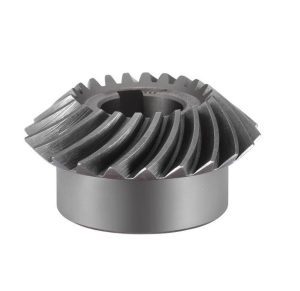
II. Different Types of Gears and Their Applications
Gears come in a variety of shapes and sizes, each with its own unique features and applications. In this section, we’ll take a closer look at some of the most common types of gears and their uses.
| Gear Type | Definition | Pros and Cons | Common Use | Photo |
|---|---|---|---|---|
| Spur Gears | Spur gears are the most common type of gear, with straight teeth that run parallel to the gear’s axis. | Pros: high efficiency, easy to manufacture. Cons: noisy, less capable of handling heavy loads. |
clocks, gear motors, conveyor systems. | 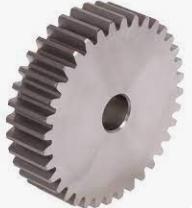 |
| Helical Gears | Helical gears have angled teeth that form a helix around the gear, resulting in a smoother and quieter operation than spur gears. | Pros: quieter than spur gears, can handle heavier loads. Cons: more complex to manufacture. | automotive transmissions, robotics, printing presses. | 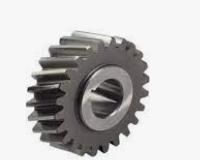 |
| Bevel Gears | Bevel gears have conical-shaped teeth and are used to transmit power between two intersecting shafts. | Pros: can transmit power at different angles. Cons: more complex to manufacture, less efficient than spur gears. | power tools, marine applications, differential gears. | 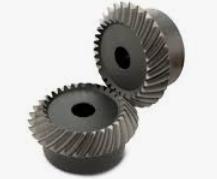 |
| Worm Gears | Worm gears combine a helical gear and a worm gear to produce a high gear ratio and the capacity to transmit power at right angles. | Pros:a high gear ratio and a compact construction cons: lower efficiency, prone to wear. |
elevators, conveyor systems, winches. |  |
| Planetary Gears | Planetary gears consist of a central gear (sun gear) that meshes with several surrounding gears (planet gears) and an outer ring gear. | Pros: high power density, compact design, can handle high torque. Cons: more complex to manufacture. | automatic transmissions, robotics, wind turbines. | 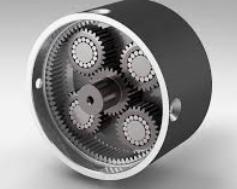 |
| Rack and Pinion Gears | Rack and pinion gears convert rotational motion into linear motion, with a straight bar (rack) meshed with a circular gear (pinion). | Pros: high efficiency, precise motion control. Cons: limited to linear motion, less capable of handling heavy loads. |
steering systems, CNC machines, linear actuators. | 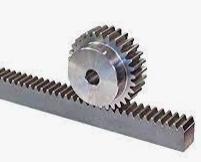 |
| Spiral Bevel Gears | Spiral bevel gears have curved teeth that form a spiral, resulting in a smoother and quieter operation than straight bevel gears. | Pros: quieter than straight bevel gears, can handle heavy loads. Cons: more complex to manufacture. |
automotive differentials, aircraft engines, heavy machinery. | 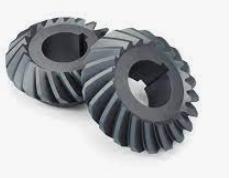 |
| Hypoid Gears | Hypoid gears have a hyperboloid-shaped gear meshed with a pinion gear, resulting in a high gear ratio and the ability to transmit power at right angles. | Pros: high gear ratio, compact design. Cons: more complex to manufacture, higher cost. | automotive differentials, power tools, industrial machinery. | 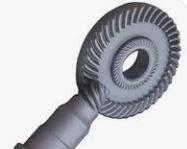 |
III. Fundamental Gear Design Parameters
There are various aspects that must be considered while building gears to ensure appropriate function. Following are some of the fundamental parameters in gear design:
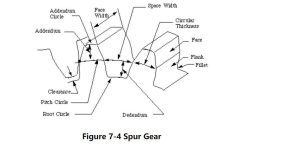
- Pitch is the spacing between adjacent gear teeth. The pitch of a gear is defined by the gear’s size and the number of teeth.
- The module specifies the size of the gear teeth. The module is the pitch diameter divided by the number of teeth on the gear.
- At the point of contact between two gears, the pressure angle is the angle formed by the line of action and the tangent to the pitch circle. The size and shape of the gear teeth are influenced by the pressure angle.
- Face width refers to the axial breadth of the gear teeth. The face width of the gear influences its load-carrying capacity.
- In helical gears, the helix angle is the angle formed by the tooth profile and the gear axis. The helix angle has an impact on the smoothness and noise level of gear operation.
- The radial distance from the pitch circle to the top of the gear tooth as an addendum. The addendum has an effect on the gear’s strength and durability.
- The radial distance from the pitch circle to the bottom of the gear tooth is measured in dedendum. The dedendum influences the clearance between meshing gear teeth.
Designers can construct gears that are optimal for their individual uses by selecting the proper values for these characteristics. It is crucial to remember, however, that these characteristics are interconnected and must be balanced to guarantee that the gear runs smoothly and efficiently.
VI. Gear Design and Selection Considerations
There are several crucial elements to consider while designing and selecting gears to achieve best performance and lifetime.
- Torque, or the rotational force necessary to turn the gears, is one of the most important things to consider. The amount of torque required varies according to the application and load requirements, and the gears must be built to resist this torque without premature failure or degradation.
- Another crucial factor to consider is speed. To avoid overheating and premature wear, the rotational speed of the gears must be carefully considered. This is especially crucial for high-speed applications such as those found in the automobile and aerospace sectors.
- Another element to consider when selecting gears is noise, especially in applications where low noise levels are crucial. Excessive noise from gears can be a sign of poor design or excessive wear, and it can have a negative impact on the overall performance and lifespan of the system.
- Finally, while designing and selecting gears, wear is a vital factor to consider. All gears will wear out over time, but the rate at which they wear out can be controlled by factors such as material selection, lubrication, and weather conditions. Using the suitable materials and lubricants, as well as performing regular maintenance and cleaning, can assist extend the life of gears and prevent early failure.
IV. How to Make Gears
Gears are critical components in many mechanical systems, and there are numerous techniques for producing them. In this section, we will look at some of the most prevalent methods for producing gear.
Casting
Casting is a typical process for mass-producing gears. The procedure is pouring molten metal into a mold that assumes the shape of the gear. The mold is removed once the metal has cooled and set, and the gear is ready for finishing.
Benefits include low-cost production, high-volume production, and complex shapes.
Disadvantages: Restricted material selections, less exact than other processes, and a rough surface finish.
Injection
Another method for producing gears is injection molding. This method is similar to casting, except that instead of pouring molten metal into a mold hole, a plastic resin is injected into it. After that, the resin is cooled and solidified to make the gear.
Benefits include low-cost production, high-volume production, and the ability to produce gears with complicated shapes.
Disadvantages: Restricted material selections, less exact than other processes, and a rough surface finish.
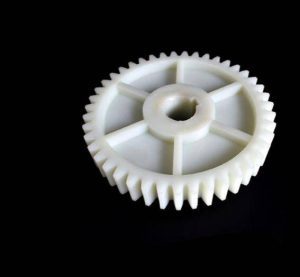
Forging
Forging is a method of shaping metal through the application of pressure and heat. A heated prepared blank is placed in a forging die to make gears. The blank is shaped into the required gear shape by applying pressure to the blank.
Advantages: Stronger, more durable gears, improved surface polish, and the ability to make complicated designs.
Disadvantages include higher costs, material limitations, and slower production times.
Cold-Drawing and Extrusion
Extrusion and cold drawing are both processes for producing long, cylindrical gears. Extrusion is the process of driving a metal billet through a die, whereas cold-drawing is the process of dragging a metal wire or rod through a die. Both processes are capable of producing exact gear forms, although they are limited to specific materials.
Benefits include high-precision, high-strength gears and a smooth surface finish.
Disadvantages: Materials are limited, and small volumes might be costly.
Metallurgy of Powder
Powder metallurgy is a method of forming solid objects by compressing and sintering metal powders. Powder metallurgy produces gears by pressing a powder mixture into a mold and then sintered at high temperatures. The final gear is then used as needed.
Benefits include precise gear designs, great strength, and the ability to construct complex shapes.
Disadvantages: Materials are limited, small volumes can be expensive, and further finishing operations may be required.
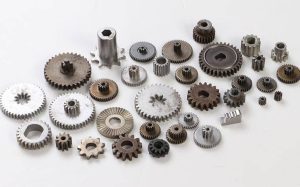
Blanking Procedure
Blanking is a typical method for producing simple gears like spur and bevel gears. Using a die and a punch, a flat sheet of metal is punched into the appropriate shape of the gear. Other machining techniques, such as turning, milling, drilling, and grinding, are subsequently used to complete the resulting gear blank to the desired dimensions and surface quality. The blanking method is appropriate for high-volume manufacture of low- to medium-precision gears.
CNC Machining Gear
Gear machining is a more sophisticated and accurate method of producing gears, making them suited for high-precision and high-performance applications such as aerospace, automotive, and medical devices. Depending on the kind and size of the gear as well as the needed precision and surface quality, this procedure may include multiple machining operations such as turning, milling, drilling, hobbing, shaping, grinding, and broaching.
The gear blank is rough-cut to the approximate shape and size using a lathe or milling machine before being machined. The gear teeth are then cut into the blank using a hobbing or shaping machine, which creates the gear teeth profiles using a particular cutting tool. Grinding or other finishing procedures are then used to complete the gear to the appropriate size and surface quality.
V Questions and Answers
1.What are the most prevalent types of machinery gears?
Spur gears, helical gears, bevel gears, and worm gears are the most common types of gears used in equipment.
2.What’s the distinction between a gear and a pulley?
A gear and a pulley both transfer power and motion, but a gear has teeth while a pulley is smooth. Gears transfer motion and power between two rotating shafts, whereas pulleys transfer motion and power between a rotating shaft and a belt.
3.What does gear lubrication serve?
The goal of gear lubrication is to reduce friction and wear between gear teeth, hence extending gear life and lowering noise.
4.What exactly is backlash in gears?
Backlash is the play between two gears’ mating teeth. Allowing the gears to move freely without binding is vital, but too much backlash can result in diminished efficiency and noise.
5.How do gear teeth become measured?
A gear tooth vernier caliper or a gear measurement machine is used to measure gear teeth. The module, which is the pitch diameter divided by the number of teeth, is commonly used to express the measurement.
6.What are some examples of common gear materials?
Steel, brass, bronze, cast iron, and polymers such as nylon are all common gear materials.
8.What are some common gear applications?
Gears are utilized in many different applications, such as automobiles, bicycles, industrial machinery, robots, and clocks.
7.Is it possible to repair or recondition gears?
Indeed, gears can be fixed or reconditioned using techniques like as grinding, honing, and lapping. Nonetheless, excessive wear or damage may necessitate the replacement of the gears.
VII. Final Thoughts
Gears are crucial components of many mechanical systems, ranging from basic devices such as clocks to large machinery such as automobiles and airplanes. We covered the terminology and basic principles of gear design, as well as the numerous types of gears accessible for diverse uses, in this comprehensive tutorial. We’ve also looked at the considerations to consider when designing and selecting gears, as well as the various methods for producing gears, such as casting, forging, and gear machining.
To achieve optimal efficiency, durability, and performance, it is critical to select the appropriate type of gear for each application. Understanding the foundations of gears will help you make informed decisions and obtain the best possible results whether you are constructing a new mechanical system or maintaining an existing one.
Finally, gears are an essential component of modern mechanical systems, and understanding how to choose, develop, and manufacture them may make a substantial difference in the performance and longevity of these systems. You may design and maintain dependable and efficient mechanical systems that match your individual needs and requirements by implementing the principles and practices outlined in this guide.
Worthy Hardware is a CNC manufacturing and sheet metal fabrication company,including CNC machining services,CNC milling services, CNC turning services, laser cutting services and stamping services.Call us +86-76989919645 or email us [email protected] for more discounts for your projects.

